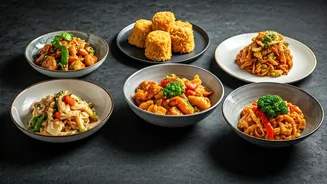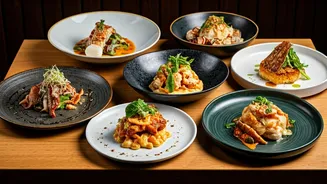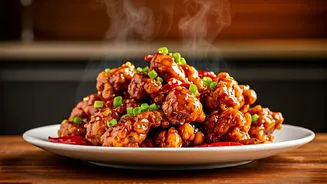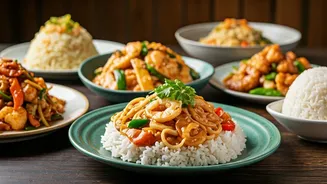The Real Story
The world of food is full of surprises, and the dishes we believe originate from a particular place don't always tell the whole story. This is true for
many dishes we commonly perceive as Chinese food. These culinary staples, beloved globally, often have a more complex past than we realize. This exploration will show how cultural exchange and culinary adaptation have led to some fascinating results, transforming familiar flavors and creating new dishes.
General Tso's Chicken
General Tso's Chicken is arguably the most famous dish on this list. It is a sweet and spicy chicken dish, a staple in North American Chinese restaurants. Its origin, however, isn't from China; it was created by Peng Chang-kuei, a Hunan chef, who fled to Taiwan. It's named after a Qing dynasty general, Zuo Zongtang, but the dish itself is a Taiwanese-American invention, a result of culinary innovation adapting to local tastes. The dish's popularity soared in the United States, becoming a symbol of Chinese-American cuisine.
Chop Suey Uncovered
Chop Suey, often thought of as a classic Chinese dish, also doesn't have a direct lineage to China. The name itself, meaning 'mixed pieces' in Cantonese, hints at its creation. This dish, featuring a stir-fry of meat, eggs, and vegetables, is believed to have originated in the United States. Its story is often linked to the Chinese immigrants who came to the US during the Gold Rush era. Chop Suey emerged as a way to use up leftovers, quickly becoming a popular dish in Chinese-American restaurants and spreading across the US.
Fortune Cookie Mystery
The fortune cookie, the iconic symbol of a Chinese meal ending, is another item that didn't originate in China. These crisp, sweet cookies with paper fortunes were actually popularized in the United States. While the precise origin is disputed, both Japan and the United States claim to have introduced the dessert. The cookies gained popularity in the early 20th century in California, quickly becoming associated with Chinese restaurants. Their appearance at the end of a meal has become a beloved tradition, even though they have a surprising origin.
Egg Rolls Evolution
Egg rolls, often a favorite appetizer, are another item that doesn't have its roots in China. The classic deep-fried rolls filled with shredded vegetables and meat were likely developed in the United States. These rolls are inspired by spring rolls, but egg rolls were modified to suit the preferences of American diners. The crunchy texture and flavorful filling have made them a staple in Chinese-American cuisine. They demonstrate how immigrant cuisines have evolved as they incorporate local tastes and available ingredients, taking their own shape and form.
Orange Chicken Origins
Orange Chicken, similar to General Tso's Chicken, is another dish that has its origins in the Chinese-American culinary landscape. The dish features crispy pieces of chicken coated in a sweet and tangy orange sauce. The exact beginnings are uncertain, but it’s clear that the dish was created to suit the palates of American diners. Similar to other dishes, this adaptation underscores the fusion that takes place when global cuisines intersect. It’s a testament to how flavors and techniques are modified across cultural boundaries.
Sweet and Sour
Sweet and Sour dishes, like sweet and sour pork or chicken, are a common offering in many Chinese restaurants globally. While this sauce is inspired by traditional Chinese flavors, the way it's prepared and presented today has been heavily influenced by Western preferences. The combination of sweetness and tanginess, paired with meat or vegetables, has become a culinary staple. This exemplifies how culinary traditions blend, resulting in distinct and evolving tastes, which have been adapted over time. The dish’s continued popularity is a sign of how flavors are reshaped by different cultures.














